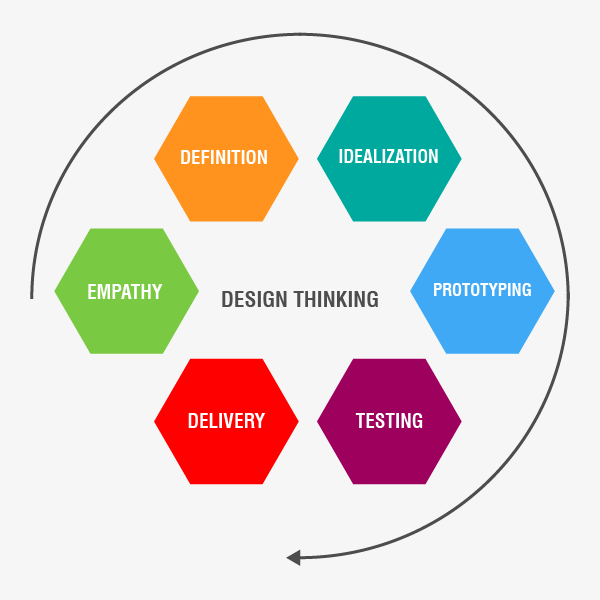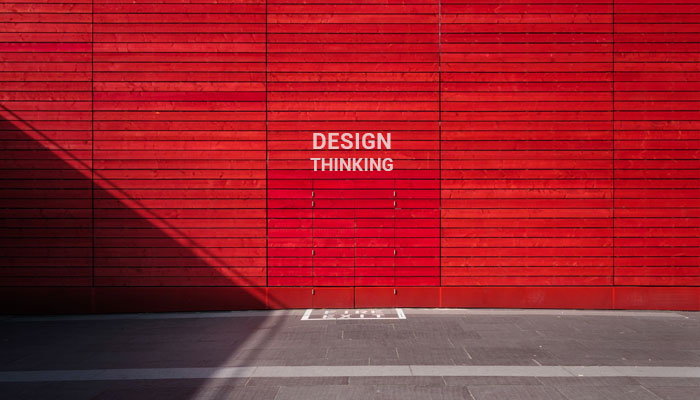Design Thinking can be used to find innovative solutions to problems in various areas. In this process, putting yourself in the customer’s shoes, idealizing solutions, prototyping and testing are important steps to achieving an ideal and value-added result.
What is Design Thinking?
Design Thinking is a methodology used for solving complex problems through new ideas as well for finding solutions for clients. This practice goes beyond the conventional flow of problem-solution; it involves the ability to use intuition, recognize patterns, construct ideas that are emotionally meaningful and valued, and other steps like prototyping and testing.
The Design Thinking process
The process has 6 steps: empathy, definition, idealization, prototyping, testing and delivery. This same process could contain a different number of steps, but each step must represent a key that adds to value the whole process. Thus, for the purposes of this article, it was divided into 6.

Design Thinking for software development Khomp
Design thinking involves creativity and people, so there is no recipe or formula for bringing innovation to your creative process. In context, it will work like learning through new behaviors, because people have different ways of thinking about how to solve the same problem. In regard to people, it may be discomforting for some to interact with the team or your client early on, or even to conduct a series of experiments and feel that the expected result was not achieved. And this is precisely the purpose of the process: to learn through new behaviors. Because it is highly interactive, each execution of an additional step in the process will be more confident and productive.
Two more keys in the process are the team and the space. A multidisciplinary and diverse team enriches the number of ideas, so there may not only be members from the same industry, but also managers, designers and developers from other areas. Finally, a good space is fundamental for the work, because it helps with the team’s creativity. This process requires communication, so it is necessary to have a place for the exchange of ideas among members, whether verbally or virtually, using software designed for this purpose, or even physically, through post-it notes on the walls. In addition, the space should be adequate for prototyping your ideas.
Let’s go to the steps.
The 6 Steps of Design Thinking
Empathy
This step should be for learning as much as possible about the topic and future users of the solution that is the result of this project.
For this, it is necessary to focus on the perspectives of the users, observe their actions, learn their needs and be able to put themselves in their shoes. The interview is a tool capable of helping with empathy. By choosing people involved in your topic, observing and interviewing, learning from experiences and emotions, you will increase your perspective. Seek to learn from extremes, expert users, and analogues as well. They will give you not just new insights, but they will also establish the thresholds in your user range.
Definition
It is the clear and objective “point of view,” for the whole team, of the problem outlined.
This step outlines the problem, using the register of needs and knowledge that were discovered during the empathy step. This information will be shared with the team of developers so that everyone can arrive at the same viewpoint. Here tools such as the creation of personas can help in the process, which will result in a much clearer definition of the problem.
Idealization
The step of generating alternatives, without judgment, and directional concepts.
In other creative processes, the well-known brainstorming tool is often used. This tool should also be used here and it should be extended. This is the phase involving the creation of many unexpected options for the problem defined in the previous phase.
The truly unexpected solutions will come from the diversity of the operational team, as mentioned previously. The non-judgment of ideas during their construction is also a key factor for enabling the process to flow. This may not generate a valuable idea, but it will create new connections in the midst of everyone’s ideas, reinforcing the chance for new big ideas to emerge. Finally, it allows the combination of ideas to generate new ideas for the exercise of creativity and innovation. The probability of arriving at a genuine and representative idea for the problem will be even greater.
After getting to the point where there are many ideas scattered around the room, the team must choose one or more concepts that serve the problem as it has been defined. This new definition will serve the next step.
Prototyping
Try and learn.
Prototyping should be encouraged to be thought of as an attitude and not as something to be delivered. At this stage you are not looking for the right solution, but how to learn as quickly as possible. A prototype should be something small and simple, so you can learn what will work or what should be discarded.
The best option for a prototype is that it be experimental, the interaction of the material with the user is what will be able to show what actually works.
Testing
The collection of experiences acquired from the prototypes.
At this point, the solutions that were idealized and prototyped will be validated by the user, who must be free to test the prototype entrusted to him in n ways. Based on the evaluation of use, observation, questioning and opinion, it will be possible to perceive what worked. Now that feedback has been given and new points have been understood, the prototype can be adapted and new users can use it to renew their feedback loop.
Delivery
Your first deliverable result.
After adapting its prototype several times and collecting positive and negative information, the moment arrives for the materialization, together with the team, of what the deliverable will be.
At this point the cycle is renewed. Once this deliverable is ready, it can be presented not only to the initial user, but also to the expert. With each new interaction, a new, more mature product that is closer to its ultimate goal, will be presented.
Final considerations
Every problem can best be solved with creativity and innovation. Just like any other situation, such as product development, customized solutions for clients with challenging briefings and even day-to-day moments. However, these words, “creativity” and “innovation” generate an almost blocking tension in those who need these tools to generate solutions. Design thinking presents itself as a methodology to be used to assist in this process, thus making it more creative and innovative.
In business, it is important to reflect on whether this process really works for your team, your project and your business. In this respect, all stages of the process can (and should) be adapted to produce new behaviors and results that will bring the team better adaptation and performance.
References:
KATZ, Tim; BROWN, Barry. Design Thinking: uma metodologia poderosa para decretar o fim das velhas ideias. Editora Elsevier, 2010.
GEKELER, Moritz; GUERTLER, Jochen; KEMBEL, George. Developing Software Using Design Thinking. OpenSAP, Edition Q1/2017. Disponível em: https://goo.gl/JA3QTz.

